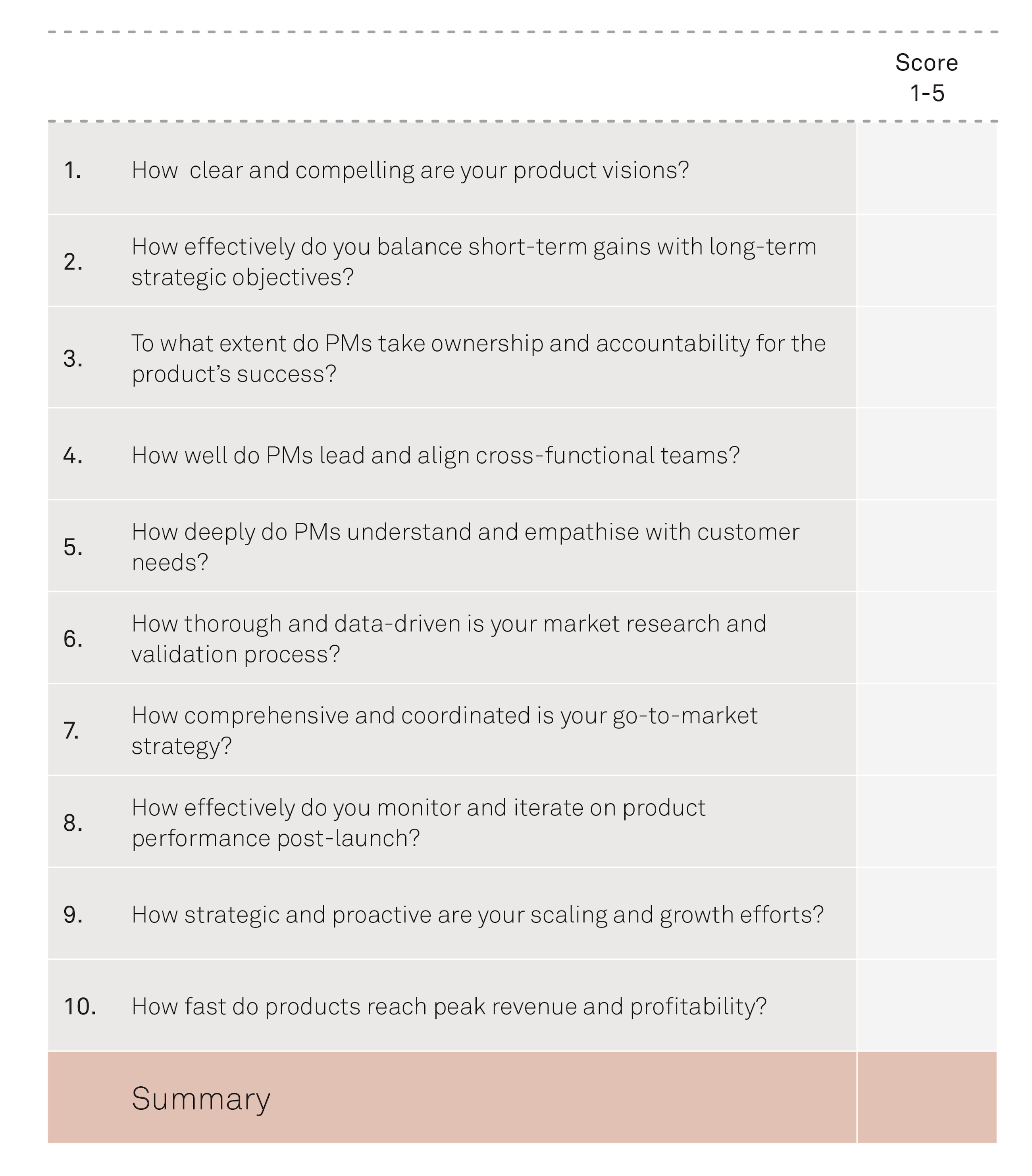Article
A perspective on product management excellence
Published
15 November 2024
In a world of technology, engineering and innovation, the product manager (PM) is at the helm, steering the ship towards success. Often described as the “CEO of the product”, a product manager embodies a unique blend of visionary leadership, strategic thinking and hands-on execution.
Over the past years, we have helped hundreds of great companies drive growth through their products and services. An impact lever that stands out very clearly from this experience is the critical role of product management. With the term product management, we mean management of physical as well as digital products and services. In this article, we dive into the dynamic world of product management, exploring the role of the PM as the product’s CEO, the essential skills and methodologies they leverage and the tools that power their products from concept to market impact.
The product manager as the CEO of the product
In a fast-paced, high-stakes product development environment, the product manager is not just a cog in the machine but the driving force behind the product’s success. Much like a CEO, a PM is responsible for the product’s vision, strategy and execution.
Here is how a PM mirrors the role of a CEO:
- Visionary leadership: A product manager must have a clear, compelling vision for the product. They are the chief architect of its future, envisioning what it can become and how it will impact the market. This vision acts as a north star, guiding every decision and rallying the team around a common goal.
- Strategic decision-making: As a business leader, a PM is tasked with making strategic decisions that balance short-term gains with long-term objectives. They must assess market opportunities, analyse competitive landscapes and determine the best path forward. Their decisions can make or break the product’s success.
- Ownership and accountability: A CEO takes ultimate responsibility for the company’s success or failure, and a PM does the same for the product, covering the whole product life cycle. This ownership mindset drives them to take bold risks, push boundaries and relentlessly pursue excellence. They are accountable for the product’s performance across regions/segments as well as cost and complexity levels from initial concept to market success and beyond.
- Cross-functional leadership: PMs often lead without direct authority but are still accountable for driving and inspiring cross-functional teams, including engineering, operations, design, marketing and sales. They create alignment across different stakeholders, ensuring that everyone is working towards the same vision. This requires exceptional communication and collaboration skills. In development, they obviously play the role of product owner, but often, they also have to take on a programme/project leader role as they cannot rely on R&D to take end-to-end accountability.
- Customer-centric focus: Successful business owners are obsessed with their customers, and PMs are no different. They champion the voice of the customer within the organisation/team, inspiring team members to ensure that the product solves real problems and delivers exceptional value. This deep empathy for the user drives every aspect of the product’s development.
Key tasks to perform in the product life cycle
Product managers take on critical responsibilities throughout the product life cycle, from inception to retirement. Below are the key tasks that need to be performed with excellence:
Methodologies that fuel success
In the relentless pursuit of product excellence, PMs leverage powerful methodologies that keep their product on the cutting edge of development. Three prominent approaches are Agile, Lean Startup and DevOps.
Agile methodology: Despite some buzzword fatigue around the word “Agile”, it is a universal mindset that emphasises flexibility, rapid iteration and customer feedback. Agile PMs thrive in dynamic environments, breaking down development into sprints and delivering incremental value. This approach increases continuous improvement and responsiveness to change.
Lean Startup: The Lean Startup methodology is all about speed and efficiency. But it starts with defining the big/long-term vision and creating a road map of different release stages in order to reduce investment risk. It champions building a minimum viable product (MVP) to quickly test assumptions and gather user feedback. The development and life cycle investments are conducted based on the “metered funding principle”, exactly like a venture capital firm would invest in a promising startup. This lean approach minimises waste, accelerates learning and reduces the risk of developing expensive products that miss the mark.
DevOps: DevOps is a set of practices that combine development (Dev) and operations (Ops) to shorten the development life cycle and continuously deliver high-quality products and modifications. By establishing a strong culture of collaboration between developers and operations teams, DevOps enables faster releases, reduces downtime and improves overall product reliability. DevOps was pioneered in software development but is now spreading fast across physical/hybrid product companies in automotive, med-tech and consumer/industrial electronics.
How the best companies organise their product management
Top-performing companies understand that effective product management is crucial to their success. Here is how they typically organise their product management functions:
A: Clear targets and a flexible structure for adapting to market changes: Leading companies establish a well-defined yet adaptable structure with roles such as associate PM, PM, senior PM and director of product. This flexible framework helps streamline accountability and decision-making while providing a clear career progression path for PMs.
B: Continuous and frequent tracking of business impact: PMs must ensure the definition of impact hierarchies and impact tracking all the way from the beginning of product development to “end-of-life”. Digital product companies often have a preference for the OKR framework, but many other methods work as well. The key is to track both lead and lag indicators.
C: Cross-functional teams: They form fixed cross-functional product teams that include members from engineering, design, marketing, sales and customer support. These teams work closely under the leadership of a PM, ensuring that all perspectives are considered in product development and the whole life cycle.
D: Dedicated customer insights team: To maintain a customer-centric focus, the best companies have dedicated teams for market research and customer insights. These teams provide valuable data and feedback that inform the product strategy. The insights team is located close to the product teams to ensure that gathered insights are always relevant and validate key product development assumptions.
E: Regular training and development: Continuous learning is a priority. Top companies invest in regular training programmes, workshops and conferences to keep their PMs updated on the latest trends, tools and methodologies.
F: Empowerment, autonomy and accountability: Successful organisations empower their PMs with the autonomy to make decisions. This trust fuels innovation and allows PMs to respond swiftly to market changes. However, empowerment without accountability will generate confusion and waste. The best companies establish P&L accountability for PMs – perhaps shared with sales or other commercial units.
Survey: Assess the strengths of your product management system
Evaluate your company’s product management system by rating each of the following questions on a scale from 1 to 5, where 1 is the lowest (needs significant improvement) and 5 is the highest (industry best practice).
Scoring and improvement activities
Add your scores to assess the overall strength and improvement potential of your product management system:
The future of product management: Leading the charge
The landscape of product management is ever-evolving, shaped by technological advancements and shifting consumer expectations. Powerful trends like sustainability, localised supply chains, artificial intelligence (AI) and machine learning (ML) are revolutionising how products are developed and managed. AI and ML can provide deeper insights into user behaviour, automate routine tasks and enhance decision-making, giving PMs a strategic edge.
As remote work becomes the norm, PMs must adapt to new ways of leading distributed teams and leveraging digital tools. The ability to inspire and drive results across geographical boundaries is becoming increasingly important.
In this brave new world, the role of the product manager will continue to be central to driving innovation and navigating change. By embracing new technologies, driving a culture of continuous learning and maintaining a relentless focus on the customer, PMs can lead their products to new heights.
Keep pushing for the next level
Product management is crucial for growth and long-term relevance. It is a way to spread the business owner’s mindset much wider throughout the organisation. Winners win because even when they are good, they keep pushing for the next level. And in the spirit of excellence and continuous improvement, there is always a next right step you can take.
We wish you all the success in the world creating engagement, curiosity and ultimately unprecedented impact with your products and services.
Want to know more?0 8
0
8For further inspiration, insights and ideas, please reach out:
Related0 4
Article
Read more
Don't develop products - develop business
How can we mitigate the cliff between today and the business results we dream about?Article
Read more
Nordic Hydrogen – poised for lift-off, but still on the runway
Why hydrogen – and why now?Article
Read more
The insurance company of the future
What trends will define the future of the Scandinavian insurance industry.Article
Read more







